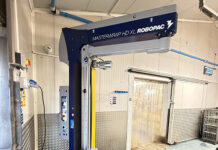Daren Spice, sales and marketing director at Gordian Strapping, discusses the benefits of stretch hooding
ONCE pallets have been secured for transit, often with plastic strapping, there are three main ways to protect them from dust or water ingress: Shrink Hooding, Stretch Wrapping and Stretch Hooding. This article compares all three methods and explores why stretch hooding has become so popular.
SHRINK HOODING
A heat shrinkable polyethylene hood is shrunk to the pack using hot air emitted from gas burners. On modern machines, the flame is only ignited during the shrinking operation which ensures considerable energy saving compared to earlier technology, where burners were ignited during the whole production shift.
STRETCH WRAPPING
LLDPE stretch film is applied to the pack, either while the pack is rotating (turntable wrappers) or while the film carriage rotates around the pack (rotary arm or ring wrappers). A top sheet can be applied to the pack, however even the most advanced wrappers cannot guarantee that no water can trickle between the top sheet and the layers of stretch film.
STRETCH HOODING
A stretchable, polyethylene hood is applied to the pack without using gas burners. Like stretch wrappers, some stretch hooders can apply an extra layer of film around the base of the pallet for added stability (roping function). A unique feature of stretch hooders, compared to shrink hooders, is the ability to re-align the hood and continue hooding if the product is not perfectly aligned on the pallet, rather than stopping the machine to report a fault.
PRODUCT BRANDING
Shrink or stretch hood film can be pre-printed making it easy to display the customer’s logo. Although stretch wrap can be pre-printed, the final pack presentation would not look as attractive as a hooding machine because, as the machine applies several layers of wrap, it is not possible to guarantee correct placement of the logo each time.
WHY STRETCH HOODING?
Given that stretch wrapping cannot fully protect the pack from water ingress, and shrink hooding involves a costly gas bill (typically £0.05 per pack), stretch hooding is gaining in popularity in many industries including food, beverage, spirits, building products and animal bedding.
Modern stretch hooders can be installed over existing conveyors and can hood the pack down to bottom of the pallet, without the need for a pack lifting device. Eliminating a pack lifter reduces capital expenditure and increases production output (a lifter can add 5 seconds to the cycle time). A lifter is often used on shrink hooders to lock the hood underneath the corners of the pallet to provide maximum stability. Stretch wrappers often require lifters to ensure that the film is applied to the bottom of the pallet.
Opening the stretch hood is a critical part of the process. Failure to open the hood properly will cause a stoppage that requires the operator to intervene, and results in the hood being removed and transferred to the packaging waste bin.
Stretch hood film and stretch hooders have come a long way in the last 20 years. Stretch hooders used to be more expensive than shrink hooders, and the choice of stretch hood film suppliers was limited.
Nowadays, both types of equipment are broadly similar in cost, the number of stretch hood film producers has grown, and stretch hood film is now widely available in 40, 50, 60 and 70 µm, as opposed to 100 µm (or higher) when it first came on the market.
From a packaging perspective, the cost savings are compelling: based on a 1200L x 1000W x 500Hmm pallet, the cost to stretch wrap a pallet with 23 µm power stretch film + top sheet (600g total) is approx. £1.14, whereas the cost to stretch hood the same pallet with 90 µm film is approx. £0.64. Similarly, moving from a 125µm Shrink Hood to a 70µm Stretch Hood could result in a saving of £0.94 per pack.















